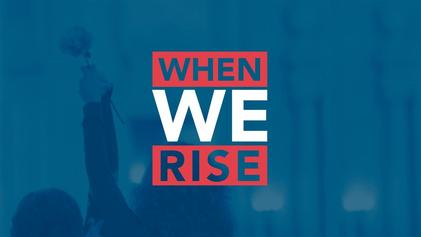
The Making of ABC’s Miniseries ‘When We Rise’ and the Real People Behind the Story
I have been asked by my CBA colleagues to share some of my experience participating in the making of ABC’s miniseries When We Rise, written by Dustin Lance Black. The miniseries aired the week of February 27 and aimed to chronicle the personal and political struggles, setbacks, and triumphs of a diverse family of LGBT men and women over the past 40 years, from Stonewall to Marriage Equality. Little did we know, when this project started over four years ago, how timely the telling of a movement-building story would be.
The story is told through a fictional adaptation of the lives of Ken Jones, Cleve Jones, Cecelia Chung, Roma Guy (my life partner and wife), our family, and me. (Note: none of the Jones’ in this story are related except as lesbian and gay brothers and sisters).
I came of age as an activist as a product of the global mass movements of the 60s and 70s. Arriving in San Francisco in 1975, I found my place in Radical Feminism (culminating in the Women’s Building) as well as the anti-imperialist and Peace movements, especially during the Central American wars of the 70s; and on the Left and as a lesbian in the LGBT movement. I was and am a “commie/pinko/queer.” These movements, and the institutions that supported them, made me who I am today and gave me the life I share with Roma, my family, and my community here in SF.
As a new graduate from SF City College’s Nursing school, I was assigned to SFGH’s Adult Medical unit in 1982, where half of the patients were (mostly) young gay men dying of this new disease whose name had just been changed from GRID to AIDS. I spent the next 34 years working at SFGH, on the inpatient HIV unit, Emergency Department, Health at Home and finally, at Ward 86, the outpatient HIV clinic.
The HIV storyline in When We Rise pretty much ends in the 1990s with the advent of HAART. While Cleve, Ken and Cecilia are all three long-term survivors of HIV, little is depicted about the challenges this involves. But it does show some of the early fight and the coming together of medical, public health, community and political activists to mount the response, including the Names Quilt and Act UP. And these lessons hold true today.
HIV is a story of how an infectious disease, a sexually-transmitted disease, was and continues to be used to attack the civil and human rights of individuals all around the world as well as intersecting that with the cruel war on drug users. An African-American, 18 year-old gay man, growing up in the Bayview district in San Francisco today, has a 50% change of acquiring HIV in his lifetime (CDC/HIV Among Gay and Bisexual Men/ 2017).
These health injustices exist all across the nation. The HIV epidemic is raging out of control throughout the South. If you superimpose the Civil War map, the map of states that refused to do Medicaid expansion under the ACA/Obamacare and the map of where HIV is raging out of control in the US, they nearly perfectly match up. And it’s black and brown gay and bisexual men and their female partners who are acquiring HIV when the rates for white gay men and women are going down–all driven by lack of access to healthcare and stigma. Indiana had one of the worst HIV and HCV outbreaks in modern global history just two years ago, directly tied to then Governor Mike Pence’s outlawing needle exchange and criminalizing drug users.
There are deep issues of racial, gender and sexual justice that are driving the HIV epidemic all around the world. In the end, it’s stigma, poverty, human and civil rights violations that are the drivers of this epidemic. And this means that we will never end this epidemic –an epidemic we know how to end and could actually end— without all of us rising up.
This is what When We Rise has meant to me.